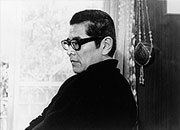Name Ryu Mitsuse Role Fiction writer | Died July 7, 1999 Education University of Tsukuba | |
 | ||
Books Ten Billion Days and One Hundred Billion Nights | ||
Ryu Mitsuse (光瀬龍, Mitsuse Ryū, March 18, 1928 – July 7, 1999) was a Japanese science fiction writer. In the West he might be best known for manga-related works and the story The Sunset, 2217 A.D. which appeared in Frederik Pohl's Best Science Fiction for 1972.
Contents
Biography
Mitsuse was born at Minami-Senju, Kita-Toshima District, Tokyo Prefecture in 1928. His birth name was Chiba Kimio (千葉 喜美雄). After marriage he adopted his wife's surname as his surname, taking the name Iizuka Kimio (飯塚 喜美雄).
He went to Tokyo in 1948. He entered into various schools, that is, the Toyo University and the Meiji University. But he stayed there for several months. He entered into Kawamura High school in 1948, and graduated from this school. He entered into the Department of agriculture in the Tokyo University of Education in 1949. He graduated from the Department of science of this university in 1953.
Mitsuse joined Kagaku Sousaku Club where Takumi Shibano was operating as a publisher and an editor of the Fanzine Uchuu-jin. He started publishing various short novels in the fanzine Uchuu-jin (宇宙塵) under the pen-name Mitsuse Ryu.
As an SF novelist, he created the Space Chronicles series. His early long SF novel Tasogare ni Kaeru (黄昏に還る) belongs to this series. Most of his short SF stories constitute this series. Rakuyou 2217 nen (落陽2217年, The Sunset, 2217 A.D.) is one of these stories.
Works
In Japanese science fiction he might be better known for the novel Ten Billion Days and One Hundred Billion Nights (百億の昼と千億の夜), which combines interest in technology and the Buddha. It was ranked the top of the Japanese SF novels in a 2006 poll by the SF Magazine. Ten Billion Days and a Hundred Billion Nights was adapted into a manga by Moto Hagio in the late 1970s.[1]
